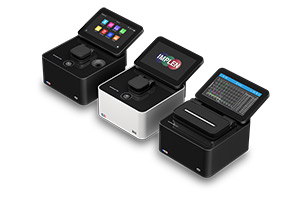Measuring Protein Concentration in Cell Lysates by Direct UV280 Absorbance in the NanoPhotometer® P330
NanoPhotometer® Application Notes
Renee Hirte, PhD
Implen, Inc. Westlake Village, CA
Introduction
The most rapid and reproducible method to determine protein concentration over a wide range is by measuring absorbance at 280 nm by spectrophotometry. Accomplishing this task in the past has often been met with the challenge of working with limited volumes of valuable samples. The advent of technology and spectrophotometers allowing the use of sample volumes as low as 0.5 μl to quantify the concentration of protein has markedly facilitated this task. However, protein samples are commonly prepared in buffers containing components which may interfere with direct absorbance. This is often the case when total cell lysates are prepared using certain detergent-based buffers and protein concentration needs to be determined to ensure equal amounts of protein are used for any subsequent experiments (e.g. immunoblotting, enzymatic assays, binding assays, etc.). The most common example is the use of RIPA lysis extraction buffers formulated with SDS and/or NP-40 for preparing cell lysates. These detergents exhibit strong absorbance in the 280 nm region (A280), making RIPA unsuitable
for direct UV measurements in lysates. There are, however, alternative detergents available that do not absorb significantly in the 280 nm region and can be used for preparing cell lysis buffers including Mammalian Protein Extraction Reagent (M-PER and Tissue Protein Extraction Buffer (T-PER)3,4. Another important issue pertains to the purity of protein samples and information about their spectral properties, including their extinction coefficients. It is common to have samples containing complex mixtures of unknown proteins in which concentration needs to be measured, such as cell lysates. In this case, lack of knowledge about the sample composition or the specific extinction coefficients of their protein components creates a challenge to use direct A280 measurements, as this information is necessary to calculate the protein concentration based on Beer-Lambert law using the A280 method5.
Under these circumstances, colorimetric methods are commonly used since they do not depend on intrinsic protein absorbance. However, in order to make them quantitative, they must rely on the use of a protein standard (e.g. BSA) to create a calibration curve1. This practice assumes that the extinction coefficient of the standard protein is the same or equivalent to the proteins in the sample in terms of their chromogenic reaction in a colorimetric assay, such as a Bradford or bicinchoninic acid (BCA) assay. In this application note, the NanoPhotometer® P-Class Model 330 was used to quantify protein concentrations in total cell extracts by direct A280 readings. These extracts were obtained by lysis of cultured cells using three different common extraction buffers RIPA, M-PER and T-PER which are all commercially available (Thermo Scientific). In contrast to the stringent denaturing RIPA buffer, M-PER and T-PER are formulations of buffers containing a proprietary non-denaturing detergent in a bicine-based buffer and used to prepare total extracts from cultured cells or tissues. Non-denaturing buffers have the benefit of maintaining native protein conformation and may be used for extraction when the protein of interest is detergent-soluble6. Results obtained from A280 measurements were compared with those using a colorimetric method (BCA) in the same samples. A conversion factor was calculated, which allows the application of the much simpler and expeditious A280 method to comparable samples, thereby saving time and reagents while providing accurate results.





